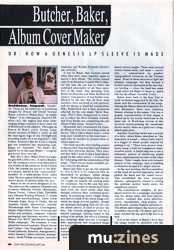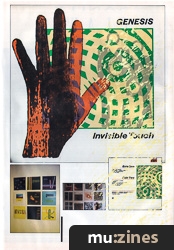Magazine Archive
Home -> Magazines -> Issues -> Articles in this issue -> View
Butcher, Baker, Album Cover Maker | |
OR: HOW A GENESIS LP SLEEVE IS MADE | GenesisArticle from One Two Testing, September 1986 | |
Genesis to revelation


Boldness. Impact. Simplicity. These are the hallmarks of marketing designs by 26-year old David Terence Baker, known as "Baker Dave" or simply "Baker" to his colleagues at Assorted iMaGes (Ai), the biggest and most wide-ranging design company to have come out of British pop in the eighties. The eagle on Simon le Bon's yacht Drum came deeper recesses of Baker's mind, as did the man-figure logo of the StrongRoom recording studio (Is it an engineer?). Phil Collins' insistence that he is just a regular guy was translated into marketing campaigns for 'Sussudio', 'No Jacket Required' etc by this same Baker — a regular guy if ever there was one.
But, like Collins, Baker Dave is a regular guy with a difference. A native Eastender, he conducts a mean funk disco and is star bowler of the infamous Bank Cricket Club. His friends are known as the Baker's Dozen, and he is the "organisation" member of a multi-media band called John. He may appear bold and simple, but there's plenty of subtlety under the skin.
Baker is one of seven designers at Ai. The others are the company's founder and co-owner Malcolm Garrett (Buzzcocks, Duran Duran, Culture Club, Eno/Mills etc), Damian Wayling (Heaven 17, Drum book and merchandising), Dave Crow (Outside Edge, Keep It Dark), Steven Appleby (books, illustrations, recently Woodentops with Panni Charrington), Mighty Nigel (Helen Terry, Antenna and Dome hair products, computer software packaging) and freelance member Garry Mouat (Yes '90125' and the new Spandau Ballet campaign). The company is completed by Garrett's partner, Duran Duran and Culture Club biographer Kasper de Graaf (editorial, financial, management), writer Jessamy Calkin (editorial, management), Sarah Phillips (accounts, customer relations) and Rosina Permaul (secretarial, artwork).
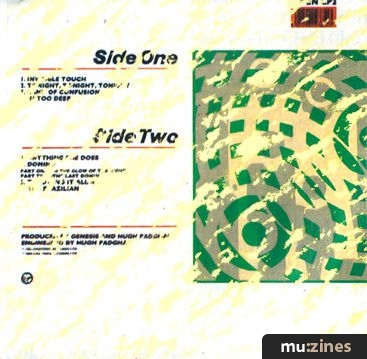
It was to Baker that Genesis turned when they were came together again to record a new album. The initial contact came from drummer/vocalist Phil Collins, but this time the job was to reflect the combined personality of all three members of the band, thus including Tony Banks (keyboards) and Mike Rutherford (guitars, bass guitars). It was further complicated by the fact that all three band members were involved in solo projects, and not always to hand for consultation. Mike Rutherford had a busy promotion schedule for his solo single 'Silent Running'. Phil Collins disappeared to America to collect his three Grammy Awards, and Tony Banks was completing his solo album of film music, 'Sound Tracks'.
Meanwhile they constructed the Genesis album at their own recording studio in Surrey. This is where Baker went — a few stops past Guildford on the local train — each time he needed to present ideas or obtain approval.
The band used the first briefing session to discuss what they had liked and disliked about their previous sleeves. They stressed they didn't want to use a band photograph on the outer sleeve — it would not be "in keeping with the construction of the songs." There was no music available yet, nor a title for the album.
Baker had little to go on, but returned to Ai's U.N.C.L.E.-inspired HQ in Shoreditch to produce 'initial design roughs.' With longstanding clients the initial roughs are usually the starting point for campaigns, but in this case they provided an opportunity to obtain more feedback from the band about what they thought reflected their combined personality. In producing initial roughs, designers have to think of the whole range over which the image is to be applied, though the principal packaging item (in this case the album sleeve) is used to project the idea. The Genesis assignment was for a limited campaign, relating simply to the selling of the album; but when it is limited, any campaign must provide a recognisable, appropriate and integrated image for buyers. The designer therefore has to know how to apply the ideas to all the various products in a way that is at once consistent and dynamic.
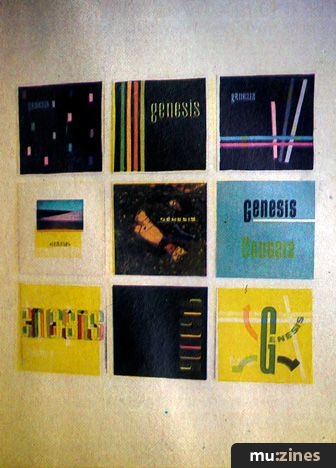
For his first presentation, Baker produced eleven roughs. There were several texture-based ideas, and some — inevitably — concentrated on graphic/typographical variations on the Genesis name. None of these survived to fight the ultimate campaign, but they formed a fruitful basis for discussion at the next Surrey briefing — when the band had some rough mixes for Baker to listen to, and a title for the album: 'Invisible Touch'.
Baker went back to the East End to work on themes suggested by the title, the music and the construction of the songs. Among the fifteen ideas developed for the next discussion, there were recurring themes relating to the senses. One was a graphic representation of how sound is picked up by the basilar membrane in the inner ear. A Warholian version of this involved screen-printing the membrane device twenty times on a grid over a magnified palm-print.
Another recurring theme was a picture of a baby, which Baker described as "the innocence of sound — when a baby cries it is a trigger to which people respond by picking it up." There were several treatments using a bold but transparent hand: invisible touch. A fourth idea was to use a schematic pattern of interfering sound waves, superimposed on some of the other themes. Other roughs dealt with broader aspects of the campaign, such as building in elements designed for singles sleeves.
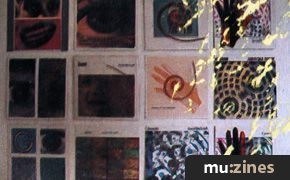
At the next briefing, the three members of the band all arrived separately, and all picked the hand and the sound waves. This established the basic campaign identity, subsequently refined by adding the symbolic nuclear family under the soundwave pattern.
The consultations complete, Ai produced artwork for a campaign encompassing the album outer and inner sleeves, cassette, compact disc, press advertisements, streetposters, shop posters, display boards, counter displays and stickers. The album and compact disc went straight to number one in the UK charts, and have since reached the top spot in the States as well.
It is in the nature of Baker's work that the image would be identified with the band, and the designer's touch should remain invisible. The album was yet another hit for Genesis; and one for bold simplicity, with more than a hint of subtlety underneath.
More with this artist
Genesis The Album (Genesis) |
At Home in the Studio (Genesis) |
More from related artists
Bruford In Crimson (Bill Bruford) |
Tony Banks (Tony Banks) |
Hackett (Steve Hackett) |
Ambisonically Yours... (Steve Hackett) |
In The Chair Tonight (Phil Collins) |
Bill Bruford (Bill Bruford) |
The Complete Phil Collins (Phil Collins) |
No Drumkit Required (Phil Collins) |
Technology's Champion (Peter Gabriel) |
And Then There Was One... (Tony Banks) |
That Genesis Touch (Tony Banks) |
Peter Gabriel - Behind The Mask (Peter Gabriel) |
Strike That Chord (Bill Bruford) |
Peter Gabriel - Passion (Peter Gabriel) |
Tony Banks (Tony Banks) |
Still Life (Tony Banks) |
Games Without Frontiers (Peter Gabriel) |
Tricks & tales (David Hentschel) |
More from these topics
Peelback |
Blue Eyed Pop - The Weird and Wonderful World of The Blue Eyed Boys |
 Airplay Action - grab your slice |
The HEX Guide To Multimedia |
Join The Singles Club |
Box Pop |
From Britain With Love: Groups |
In the Sticks with Promuco |
Politics & Pop - Are They A Good Mix? |
Six Great Moments In Sound History |
Inside TEAC Japan |
Go East Young Band - Roland Report |
Browse by Topic:
Design, Development & Manufacture
Marketing / Promotion
Multimedia / Graphics / Visuals
Publisher: One Two Testing - IPC Magazines Ltd, Northern & Shell Ltd.
The current copyright owner/s of this content may differ from the originally published copyright notice.
More details on copyright ownership...
Topic:
Design, Development & Manufacture
Marketing / Promotion
Multimedia / Graphics / Visuals
Artist:
Genesis
Role:
Band/Group
Related Artists:
Tony Banks
Peter Gabriel
Bill Bruford
Steve Hackett
Phil Collins
David Hentschel
Feature
Help Support The Things You Love
mu:zines is the result of thousands of hours of effort, and will require many thousands more going forward to reach our goals of getting all this content online.
If you value this resource, you can support this project - it really helps!
Donations for September 2025
Issues donated this month: 0
New issues that have been donated or scanned for us this month.
Funds donated this month: £0.00
All donations and support are gratefully appreciated - thank you.
Magazines Needed - Can You Help?
Do you have any of these magazine issues?
If so, and you can donate, lend or scan them to help complete our archive, please get in touch via the Contribute page - thanks!
